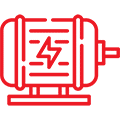Drying recorders are essential laboratory tools for evaluating the drying characteristics of coatings, inks, paints, and varnishes. A critical component in these instruments is the gearmotor, which ensures precise and consistent movement.
At Rotalink, we specialise in providing high-quality gearmotors that enhance the functionality and reliability of drying recorders.

Role of Gearmotors in Drying Recorders
Precision Movement
Function: Gearmotors control the movement of needles or pins across the coated surface in drying recorders.
Importance: Accurate movement is crucial for documenting the various drying stages, such as set-to-touch, tack-free, and dry-hard times.
Consistent Speed Control
Function: The speed at which the needle or pin moves needs to be consistent and adjustable.
Importance: Different coatings and materials have varying drying times, so precise speed control allows for accurate testing under different conditions.
Rotary and Linear Motion
Rotary Drying Recorders: Gearmotors drive the rotating disc that holds multiple samples, allowing for simultaneous testing.
Linear Drying Recorders: Gearmotors ensure the linear movement of the needle or pin along a straight path.

Types of Gearmotors Used
Stepper Motors
Advantages: Provide precise control over position and speed, ideal for the detailed movement required in drying recorders.
Applications: Commonly used in both linear and rotary drying recorders for their accuracy and reliability.
DC Motors with Gearboxes
Advantages: Offer high torque and adjustable speed control, making them suitable for driving the mechanisms in drying recorders.
Applications are often used in applications requiring higher torque and smooth operation.
Brushless DC Motors
Advantages: Known for their efficiency, low noise, and long lifespan, which are critical for the quiet operation of lab instruments.
Applications: Used in high-end drying recorders where performance and longevity are paramount.

Key Features of Rotalink Gearmotors
High Precision
Description: Our gearmotors are designed to provide accurate and repeatable motion, ensuring reliable test results.
Benefit: Helps in producing consistent and precise drying profiles for various coatings.
Customisable Specifications
Description: We offer gearmotors that can be customised to meet the specific requirements of different drying recorder models.
Benefit: Allows manufacturers to optimise the performance of their drying recorders for specific applications.
Durability and Reliability
Description: Built with high-quality materials and designed to withstand continuous operation.
Benefit: Ensures long-term reliability and reduces the need for frequent maintenance.
Compact Design
Description: Our gearmotors are designed to fit into compact spaces without compromising performance.
Benefit: Ideal for integration into the often limited spaces within laboratory instruments.

Applications in Specific Drying Recorders
Linear Drying Recorders
Function: Gearmotors drive the linear track, moving the needle or pin across the coated sample.
Example: Stepper motors provide the necessary precision for documenting each drying stage accurately.
Rotary Drying Recorders
Function: Gearmotors power the rotating disc that holds multiple samples, ensuring uniform speed and movement.
Example: Brushless DC motors offer smooth and quiet operation, enhancing the user experience.
Gearmotors are an integral component of drying recorders, ensuring precise, consistent, and reliable performance. At Rotalink, we pride ourselves on providing high-quality gearmotors that meet the stringent requirements of laboratory instruments.
Our customisable and durable gearmotors are designed to enhance the functionality and efficiency of drying recorders, making them an essential choice for manufacturers aiming for excellence in their products.











